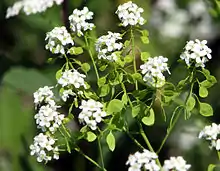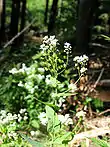Peltaria alliacea
Peltaria alliacea, or garlic cress, is a perennial plant in the family Brassicaceae, endemic to Southeastern Europe. The plant grows up to 60 cm (24 in) and flowers white from May to July. The plant is glabrous (hairless) with simple, entire leaves. The leaves are ovate, sessile and amplexicaule (having lobes that completely surround the stem). When crushed they smell of garlic, hence the common name.[2] The 3–4 mm (0.12–0.16 in) long white petals are shortly clawed. The orbicular,[2] very flat silicula or seed, is pendent and has a size of about 6 by 6 mm (0.24 by 0.24 in). Its chromosome number is 2n=14 (also: 28, 56).[3]
| Peltaria alliacea | |
|---|---|
 | |
| Scientific classification | |
| Kingdom: | Plantae |
| Clade: | Tracheophytes |
| Clade: | Angiosperms |
| Clade: | Eudicots |
| Clade: | Rosids |
| Order: | Brassicales |
| Family: | Brassicaceae |
| Genus: | Peltaria |
| Species: | P. alliacea |
| Binomial name | |
| Peltaria alliacea Jacq. | |
| Synonyms | |
| |
It was first published and described by Nikolaus Joseph von Jacquin in 'Enum. Stirp. Vindob.' on page 260 in May 1762.[1][4]
The plant grows in stony areas from Southern Austria (Styria, Lower Austria) to South Romania and Albania. It has become naturalized in the U.K.[2]
The plant is also grown as a herb or vegetable. The leaves can be used and add a spiciness to salads. Although, they can become bitter in the summer.[5]
 leaves |
 silicula |
 plant habitus |
 near Graz (Austria) |
References
- "Peltaria alliacea Jacq. is an accepted name". theplantlist.org. 23 March 2012. Retrieved 29 October 2017.
- Clive Stace New Flora of the British Isles, p. 421, at Google Books
- S.I. Warwick, I.A. Al-Shehbaz (2006). Brassicaceae: Chromosome number index and database on CD-Rom. Plant Systematics and Evolution. 259. pp. 237–248. doi:10.1007/s00606-006-0421-1.
- "Brassicaceae Peltaria alliacea Jacq". ipni.org. Retrieved 29 October 2017.
- "Garlic Cress". Plants for a Future. Retrieved October 28, 2017.
External links
| Wikimedia Commons has media related to Peltaria alliacea. |